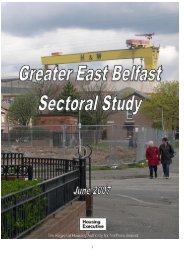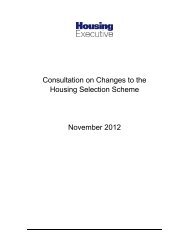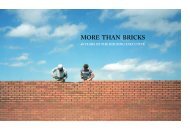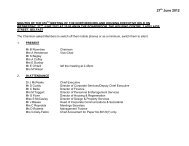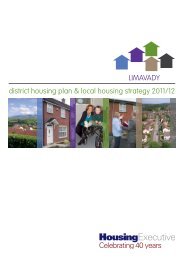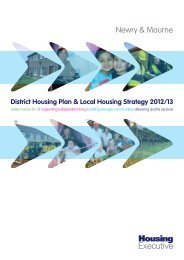House Price Index for Quarter 1 2013 - Northern Ireland Housing ...
House Price Index for Quarter 1 2013 - Northern Ireland Housing ...
House Price Index for Quarter 1 2013 - Northern Ireland Housing ...
Create successful ePaper yourself
Turn your PDF publications into a flip-book with our unique Google optimized e-Paper software.
produced in partnership with 1<br />
May <strong>2013</strong><br />
Improving Sentiment<br />
The mini-revival in house sales in <strong>Northern</strong> <strong>Ireland</strong> continued<br />
during Q1 with the largest sample of reported transactions in the<br />
quarterly survey since Q4 2007. While acknowledging low base<br />
effects in the statistics, activity levels in the market during the first<br />
3 months of <strong>2013</strong> were up over 50% on the same period in 2012. The<br />
figures may appear a little more positive in the context of the few<br />
weeks of particularly adverse weather conditions that prevailed<br />
during March and the civil disturbances in January.<br />
The survey continues to highlight significant variances by<br />
geography – the Belfast market has been especially busy over<br />
the last quarter, accounting <strong>for</strong> almost one third of sales while<br />
conditions in some of the provincial locations and more rural<br />
locations remain tougher. As in previous surveys, the more<br />
densely populated commuter locations of North Down and<br />
Lisburn continue to post relatively strong per<strong>for</strong>mances on<br />
both the quarterly and annual comparisons.<br />
With an overall average price across the region of just over<br />
£131,000, the market has returned to levels last reported in<br />
the early months of 2005. After a period of relative stability<br />
in this measure, the changing mix and distribution of sales<br />
in the lower price bands has clearly had a significant impact<br />
on pushing the overall average price lower. In this latest survey,<br />
the terraced segment represents 30% of all sales (including<br />
a large concentration in Belfast) compared to 21% in Q1 2012<br />
while detached properties account <strong>for</strong> a smaller share.<br />
Supportive of these trends is a further re-profiling of price points<br />
with nearly half of all properties now sold at or below the £100,000<br />
level and around three quarters at or below £150,000.<br />
Both cash buyers and borrowers seeing value again<br />
Higher demand from both first time buyers at the new price<br />
points coupled with investors attracted by rental yields on some<br />
properties are reported as key drivers of increased activity while<br />
some modest loosening in the mortgage market, partly as a<br />
result of the UK Funding <strong>for</strong> Lending Scheme, may also be a<br />
positive influence.<br />
While cash-buying is clearly a feature of sales volumes at the<br />
lower end of the market, the latest regional mortgage data<br />
from CML is entirely consistent with this picture with a median<br />
advance <strong>for</strong> house purchase having declined to c £75,000 and<br />
below £70,000 <strong>for</strong> first-time buyers. Interestingly, though not<br />
widely recognised, the median advance as a percentage of prices,<br />
typically 75-80%, is now higher than that which prevailed pre the<br />
financial crisis, a commentary on the hyper-inflationary nature of<br />
the market in those days.<br />
While the average income of borrowers has fallen significantly from<br />
2007 peaks, in parallel the steep correction in prices and sustained<br />
period of exceptionally low interest rates has resulted<br />
in much improved af<strong>for</strong>dability measures with typical income<br />
multiples now below 3x and average capital and interest payments<br />
now less than 20% of income. For those who can gather up a deposit,<br />
it appears the decision to buy rather than rent has become more<br />
attractive <strong>for</strong> some at the new market levels.<br />
Prospects<br />
Seasonal trends should be supportive of higher sales volumes over<br />
the next few months while as we look ahead to the remainder of <strong>2013</strong><br />
and with the average price having now declined by around 50% from<br />
peak, the downside risks now seem limited. Short-term movements<br />
will of course continue to be strongly influenced by the precise mix<br />
of property sales during each quarter.<br />
We might expect typical “starter homes” and detached properties<br />
to at least maintain their value at around current levels but in<br />
contrast, the semi-detached segment may struggle a little without<br />
a more active “home-mover” market. Variable per<strong>for</strong>mance within<br />
the region will continue to be a characteristic of the market<br />
The macro economic backdrop is expected to remain difficult. We<br />
can take some encouragement from recent signals indicating a very<br />
marginal return to growth <strong>for</strong> the private sector – led by services –<br />
but the labour market recession continues with the jobless rate<br />
continuing to tick higher and worrying trends in both youth and<br />
long-term unemployment.<br />
Despite positive job announcements in some sectors and sterling<br />
per<strong>for</strong>mances from a number of our businesses, particularly in export<br />
markets, in reality the growth rate of the regional economy is unlikely<br />
to be robust enough to trigger a reversal in labour market trends <strong>for</strong><br />
some considerable time. Labour-intensive sectors such as construction<br />
and retailing continue to face into strong headwinds and will not be<br />
engines of job creation in the short-term. <strong>House</strong>hold finances remain<br />
tight and with inflation closer to 3%, many continue to face a drop in<br />
real living standards.<br />
As expected, at a UK level the March Budget featured a package of<br />
new and expanded housing measures under a Help to Buy banner.<br />
The policy intentions are clear – to lower the deposit hurdle <strong>for</strong> creditworthy<br />
households to get on the ladder or move home and make<br />
it easier <strong>for</strong> equity-constrained borrowers to remortgage – but the<br />
schemes are embryonic in nature and the potential application,<br />
if any, to the <strong>Northern</strong> <strong>Ireland</strong> market very uncertain.<br />
Alan Bridle<br />
UK Economist, Bank of <strong>Ireland</strong> UK<br />
T: 028 9043 3519 E: research@boini.com



